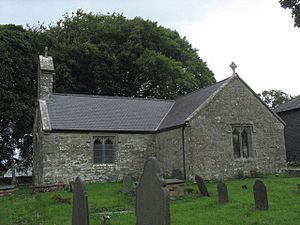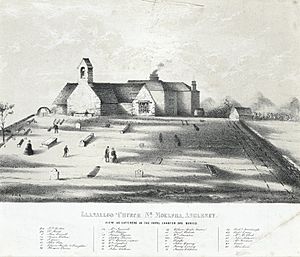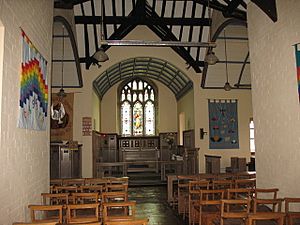St Gallgo's Church, Llanallgo facts for kids
Quick facts for kids St Gallgo's Church |
|
|---|---|

The south side of the church
|
|
| Lua error in Module:Location_map at line 420: attempt to index field 'wikibase' (a nil value). | |
| OS grid reference | SH 501 850 |
| Location | Llanallgo, Anglesey |
| Country | Wales, United Kingdom |
| Denomination | Church in Wales |
| Website | Church website |
| History | |
| Status | Church |
| Founded | Early 6th century or 605 (sources disagree) |
| Dedication | St Gallgo |
| Architecture | |
| Functional status | Active |
| Heritage designation | Grade II |
| Designated | 12 May 1970 |
| Style | Perpendicular architecture |
| Specifications | |
| Length | 24 ft (7.3 m) (nave) |
| Width | 12 ft (3.7 m) (nave and chancel) |
| Materials | Rubble masonry |
| Administration | |
| Parish | Llaneugrad and Llanallgo with Penrhosllugwy with Llanfihangel Tre'r Beirdd |
| Deanery | Twrcelyn |
| Archdeaconry | Bangor |
| Diocese | Diocese of Bangor |
| Province | Province of Wales |
St Gallgo's Church is a small, historic church located near the village of Llanallgo on the east coast of Anglesey, north Wales. While parts of the current building, like the chancel and transepts, were built in the late 1400s, there has been a church on this spot since the 500s or early 600s. This makes it one of the oldest Christian places in Anglesey. The church was repaired and made bigger in the 1800s.
This church is famous for its connection to the 1859 shipwreck of the Royal Charter. The church was used as a temporary place for the victims, and 140 people who died are buried in its churchyard. The famous writer Charles Dickens visited and wrote about the ship's loss. He was very impressed by the care given by the church's leader, Stephen Roose Hughes, to the victims and their families. Hughes himself died a few years later, partly due to the stress of these events, and is also buried there.
Today, St Gallgo's Church is still used for worship by the Church in Wales. It is one of four churches in a group of parishes. Services are held regularly in both English and Welsh. The church is a Grade II listed building, which means it's a special building that should be protected. It's known for its "Perpendicular" style of architecture and still has some original features from the late 1400s. Inside, you can find a bell from the late 1200s, old memorials, and church furniture from the early 1900s.
Contents
History of St Gallgo's Church
St Gallgo's Church is located southwest of the village of Llanallgo, close to the eastern coast of Anglesey, north Wales. It is about 6 miles (9.7 km) from Llangefni, the main town in the county.
Early Beginnings and Saint Gallgo
According to some historians, St Gallgo founded the first church here in the early 6th or 7th century. This makes it one of the oldest Christian sites in Anglesey. Gallgo was one of the sons of St Caw, a king from northern Britain. He was also the brother of St Gildas and St Eugrad, who founded a nearby church around the same time. There was once a well near the church named after Gallgo. People believed its waters had special healing powers.
The village of Llanallgo gets its name from the church. In Welsh, "llan" originally meant "enclosure" and later "church." "-allgo" is a changed form of the saint's name.
Building and Changes Over Time
Records show a church existed here in 1254. However, the oldest parts of the current building, like the chancel (the area around the altar) and transepts (the parts that stick out like arms of a cross), were built in the late 1400s.
The church has been repaired and changed many times. In 1831, a new window was added. In 1892, major restoration work was done, including rebuilding parts of the walls and making the nave (the main part of the church) longer. In 1934, the sanctuary (the holiest part of the church) was restored to remember Stephen Roose Hughes, a former church leader. In 2004, the vestry (a room for clergy) was damaged by fire but has since been fixed.
The Royal Charter Shipwreck
The churchyard of St Gallgo's holds the graves of 140 victims from the sinking of the Royal Charter. This ship sank off the coast of Anglesey in October 1859. More than 440 passengers and crew died in the disaster.
Stephen Roose Hughes was the church leader at the time. St Gallgo's was used as a temporary place to identify bodies as they were found. Hughes and his brother, who led a nearby church, conducted many of the funerals. Hughes also wrote over 1,000 letters to people asking for news about their loved ones. He comforted many visitors who came to Anglesey after the tragedy.
Charles Dickens, a famous writer, stayed with Hughes when he visited Anglesey to write about the sinking. Dickens wrote about how carefully Hughes tried to identify victims using their belongings and features. Hughes died three years later. His gravestone in the churchyard mentions that the stress from the shipwreck events contributed to his early death. He is still remembered at St Gallgo's every year on February 4th.
The churchyard also contains two graves from the Commonwealth War Graves Commission. These are for a soldier from World War I and a sailor from World War II.
Notable People Connected to the Church
The poet Dafydd Trefor was a leader of St Gallgo's and St Eugrad's churches in the early 1500s. He is buried in the churchyard. Another poet and historian, John Williams, also led both churches from 1883 until his death in 1891. He is also buried at Llanallgo.
St Gallgo's Church Today
St Gallgo's is still an active church for the Church in Wales. It is part of a group of four churches. The church is part of the Diocese of Bangor. As of 2025, the position of rector (the main church leader) is vacant.
Services are held every Sunday morning, alternating between a communion service and morning prayer. There are also evening services twice a month and a midweek communion service in the church hall in Moelfre. Retired clergy and lay readers lead these services.
Architecture and Features
The church is built in the Perpendicular style, using rough stone. The roof is made of slate, and there's a stone bell tower at the west end. The church is shaped like a cross, with parts sticking out to the north and south of the chancel. You enter through a porch on the north side of the nave. The inside walls of the nave and transepts are covered with painted bricks. The wooden beams supporting the nave roof can be seen from inside. The chancel floor is made from local limestone.
Windows and Bell
The east window in the chancel is from the 1400s, though its decorative stone work is newer. It has stained glass showing Jesus walking on water. The east windows in the north and south transepts each have a five-leaf design at the top. The windows in the nave were added in the late 1800s.
The church bell is very old, dating back to the late 1200s. It has the mark of a penny coin from the time of King Edward I (who ruled from 1272 to 1307). It also has a Latin message that means "Hail Mary full of grace." The bell was restored in 2000.
Interior Fittings
The reredos (a screen behind the altar), the altar, the communion rail, the pulpit, and the reading desk were all made in the early 1900s. They are crafted from light-colored oak in an Arts and Crafts style, with flower decorations. In the north transept, there is a stone memorial on the wall for a former rector, Lewis Owen, and his grandson, who both died in 1771. The font, used for baptisms, is modern.
Why St Gallgo's Church is Special
St Gallgo's Church is recognized nationally and protected by law. It is a Grade II listed building. This means it is a "building of special interest" that should be preserved. It received this status on May 12, 1970. It is noted as a "rural church with strong Perpendicular character" that still has some features from the late 1400s.
Historians and church experts have admired the church over the years. In 1831, one writer called it a "small and handsome structure." Another, in 1859, said it was one of the "better kind" of churches in Anglesey. He thought the church's construction showed it was built by someone very generous. In 1868, Sir Stephen Glynne, a politician and church historian, noted that St Gallgo's had been changed less than most other churches in Anglesey.



